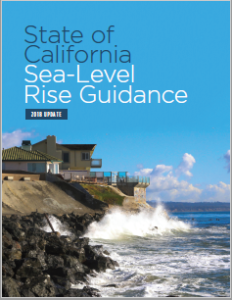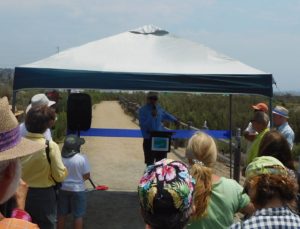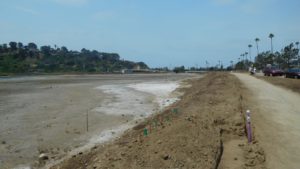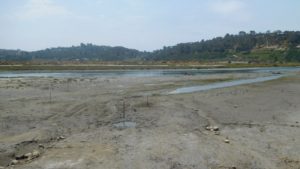A Once In A Lifetime Opportunity to Save California’s Wetlands
Here’s your chance to save our state’s wetlands! One of the state’s most precious resources, its wetlands, are under attack by the Trump administration. The US EPA is proposing to remove federal protections for these important waters. The State Water Resource Control Board (SWRCB) has the opportunity to adopt procedures that would protect these wetlands even without federal laws. They have released draft procedures that would be a great step forward in providing state protection for wetlands. Comments are due by noon September 18, 2017. Please write or email. The details and a sample letter are below.
More information at:
http://www.waterboards.ca.gov/water_issues/programs/cwa401/wrapp.shtml#announcements
For many years we have urged the State to adopt regulations to protect wetlands and in 2008 the State Water Resources Control Board (SWRCB) actually adopted a resolution telling staff to prepare such regulations. As a result we wrote to you, in 2008, “The State Water Resources Control Board (SWRCB) has just initiated a process to develop regulations to protect our State’s wetlands,” and asked you to write letters and emails in support.
Nine years later we are still saying it. Over those nine years we have seen at least 6 drafts –some pretty good (immediately attacked by developers and industrial agriculture lobbyists), some very bad (immediately attacked by us). Each time, the Water Board has yielded to the unhappy side. The next to last draft was a terrible one that would have provided almost no protections at all.
But now, facing the Trump attack on the environment (and one of those attacks is to eliminate the EPA’s recent Clean Water Rule that would have helped save our wetlands) the State Water Board (and the Governor) hopefully feel added pressure to enact a regulation that will truly protect the State’s wetlands. In fact, their latest draft is again, a good one. We are supporting it with some comments asking for a few important revisions. But it needs to get adopted and that won’t be easy – as our nine year journey has demonstrated.
Why should we care? Our last-remaining wetlands are critical for the health of our waterways and wildlife. Wetlands improve water quality by filtering toxins, protect communities against flooding, and help to replenish groundwater supplies. They also provide essential habitat for millions of ducks, geese, songbirds and shorebirds that migrate along the Pacific Flyway each year, and support fish, snakes, and other animals. Over 85% of our sport and commercial fisheries and most of our migratory bird species are dependent upon wetlands. In California, wetlands support fifty-five percent of our endangered animal species. In 1993, Governor Pete Wilson signed Executive Order W-59-93—the no-net-loss policy—to halt the destruction of California’s wetlands. However, almost 25 years after the policy’s execution, we have failed to achieve its mandate and wetland losses continue.
Unfortunately for wetlands the sad fact is that most non-tidal wetlands are found on private property and thus are easy to destroy and hard to protect. Non-tidal wetlands are those wetlands that are located in uplands as opposed to those wetlands, such as tidal marshes located in large bodies of water like oceans and lakes. Wetlands are also found most commonly in flat areas, often near rivers and streams – places where people want to live or farm. As a result, the US has lost, over the last few centuries, over 50% of its historic wetlands. Mid-west states have lost 80 to 90% of their wetlands, or even more as they were turned into agricultural lands (Iowa 98%). California is no different having lost about 90% of its historic wetlands And yet we still continue to see California’s wetlands destroyed at a rapid pace. Hundreds of acres of wetlands are lost every year.
Until 1972 and the creation of the federal Clean Water Act (CWA) wetlands had essentially no protections and, in fact, laws were passed to actively encourage their destruction (“reclamation acts”). The Clean Water Act gave the Army Corps of Engineers the responsibility to “approve” permits for wetland destruction. The intent of the law was to deny permits for harmful projects. Unfortunately, it was written so it could be interpreted in various ways and the Corps’ enforcement was weak. Over the years, with the establishment of the US EPA new rules were created that provided greater protections for wetlands, including an “Alternatives Analysis” under Section 404(b)(1) of the CWA that required an applicant to demonstrate that there is no less environmentally damaging location available for the project purpose. If such an alternative site were available the Corps should deny the permit! (That rarely happens).
The most serious issue for upland wetlands is determining which wetlands are jurisdictional (i.e., can be regulated and protected by the federal or state government). Many of these wetlands, especially in California, are seasonal, i.e., wet only during the rainy season. Vernal pools are an example of this sort of wetland. Developers and industrial agriculture claimed that if they weren’t wet all year they couldn’t be wetlands. For many years the Army Corps ruled that the presence of migratory waterbirds (ducks and shorebirds) could be considered a signifier that a wetland was jurisdictional. After all, the Clean Water Act was written to protect the “chemical, physical and biological integrity of the waters of the US”.
Unfortunately, a US Supreme Court decision called SWANCC (Solid Waste Agency of Northern Cook County v. U.S. Army Corps of Engineers (2001)) decided that the presence of such migratory waterbirds was not in itself an indication of federal jurisdiction and the Corps decided it was not an indicator at all. Next in 2006, came the court’s Rapanos decision. Here the court tied on its vote, 4 justices voted that only navigable waters (such as a rivers, streams, lakes or ocean) could be jurisdictional, 4 voted to keep things the way they were at that time –leaving it up to the agencies to decide jurisdiction and judge #9, Justice Kennedy, said –if a non-tidal wetland is shown to have some connection to a “traditional navigable water” then it is jurisdictional. Such connections can exist because the wetlands ultimately drain into navigable water, or because the wetlands flow into the navigable water during floods or by being adjacent to the navigable body. So things were even more confused with some courts interpreting the decision one way or the other.
The EPA’s Clean Water Rule, established last year, would have clarified this situation and made many upland wetlands clearly jurisdictional for federal regulation. The Trump Administration has now repealed that rule. That action is currently in litigation.
So – most of our upland wetlands are now seemingly fair game for destruction once again.
That’s why we need your help. California’s Porter-Cologne Act says that all waters of the state are jurisdictional. Our State Water Resources Control Board and its Regional Boards can, under Porter-Cologne regulate and protect our state’s wetlands regardless of what federal agencies or laws do. But they have to adopt policies and regulations to do so. And the latest version of the SWRCB’s wetlands rule is a good one that would, for the most part, protect our wetlands. We now need to encourage the State Water Board to adopt these new regulations. Perhaps most importantly, the new policy adopts a definition of wetlands that truly covers the wetlands of our state. Opponents will aggressively challenge this good definition.
But the new proposal is not perfect and so please ask the Board to make two changes. Specifically, the science of wetland restoration or creation is far from perfect and usually mitigation wetlands (wetlands restored or created specifically to make up for the destruction of wetlands by a project) don’t perform as well as natural wetlands and even when they work it often takes a decade or more before they really start to function as they should. For this reason, and in order to comply with the State’s “no net loss” of wetland acreage or function policy please ask the Board to insist that under the new compensatory mitigation policy every wetland acre destroyed or degraded must be mitigated by at least an acre of newly restored or created wetlands. This is called a one-to one mitigation ratio.
The other significant flaw is in the “Alternatives Analysis” section. The proposed policy states that every wetland-destroying project must submit an “Alternatives Analysis” showing why the project couldn’t be undertaken on a non-wetland site. This is the heart of the regulation. But the policy then states that a Regional Water Board can ignore the Alternatives Analysis requirement for any project and it doesn’t even have to provide a reason. If that is the case- wetland destruction can continue as before. Please ask the State Water Board to insist that an Alternatives Analysis must be preformed for every project.
With these changes, the “Procedures” will greatly enhance our chances to preserve our state’s wetlands.
Please email or write the State Water Board in support of the draft “Procedures for Discharges of Dredged or Fill Materials to Waters of the State”. Comments are due by noon, September 18.
The mail address is:
Jeanine Townsend, Clerk to the Board State Water Resources Control Board 1001 I Street, 24th Floor Sacramento, CA 95814
The email address is: commentletters@waterboards.ca.gov
We’ve included a sample letter to help you. Since it is always good to have individual letters you can choose how in-depth you wish to be. All letters are good even the shortest.
If you have any questions feel free to call Arthur Feinstein at 415-680-0643
Thanks!!
Sample letter. This is a minimalist letter that doesn’t address the more complicated issues we talk about above – but it is still very useful just to let the Board members know people want to save wetlands. If you want to add some comments for strengthening the “Procedures” – please do so:
Felicia Marcus Chair and Board Members
State Water Resources Control Board
1001 I street
Sacramento, CA 95814
Dear Chair Marcus and Board members:
My name is ___________________ and I am writing today to express my support for the proposed statewide wetlands policy regulation (“Procedures for Discharges of Dredged or Fill Materials to Waters of the State”), and ask you and the other boardmembers to do the same. California has lost over 90% of its historic wetlands, and we must do all we can to stop further harm, protect what remains, and rebuild some of what we’ve lost.
Wetlands provide important habitat for many native species in this state, such as birds, fish, reptiles, and amphibians. Wetlands improve water quality by filtering water. They can also provide key protections from the rising ocean levels that climate change will bring.
Despite all of this, the President has recently acted to roll back federal protections for wetlands. This is wholly unacceptable, and the state must do all it can to protect our resources from federal inaction. The State Water Resources Control Board stands in a unique position to lead in the face of federal retreat. We urge you to use your authority to adopt the statewide wetlands policy.
Sincerely,
[your name]







